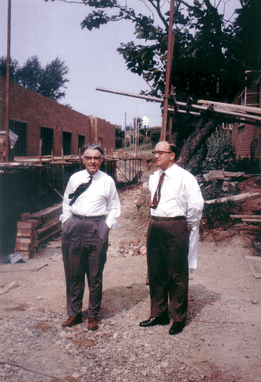Louis Harold Gray facts for kids
This article is about Louis Gray (disambiguation)|Louis Gray. For other uses, see Louis Harold Gray (disambiguation).
Quick facts for kids
Louis Harold Gray
|
|
|---|---|

LH Gray (left) and J Boag supervising construction of the Gray Laboratory at Mount Vernon Hospital in north London.
|
|
| Born | 10 November 1905 |
| Died | 9 July 1965 (aged 59) |
| Education | |
| Known for | Bragg–Gray cavity theory Gray (unit) |
| Spouse(s) | Frieda Marjorie Picot |
| Parents |
|
| Awards |
|
| Scientific career | |
| Institutions |
|
| Thesis | (1930) |
| Doctoral advisor | James Chadwick |
| Author abbrev. (botany) | |
Louis Harold Gray FRS (10 November 1905 – 9 July 1965) was an English physicist who worked mainly on the effects of radiation on biological systems. He was one of the earliest contributors of the field of radiobiology A summary of his work is given below. Amongst many other achievements, he defined a unit of radiation dosage (absorbed dose) which was later named after him as an SI unit , the gray.
Career
- 1933 - Hospital physicist at Mount Vernon Hospital, London
- 1936 - Developed the Bragg–Gray equation, the basis for the cavity ionization method of measuring gamma-ray energy absorption by materials
- 1937 - Built an early neutron generator at Mount Vernon Hospital
- 1938 - Studied biological effects of neutrons using the generator
- 1940 - Developed concept of RBE (Relative Biological Effectiveness) of doses of neutrons
- 1952 - Initiated research into cells in hypoxic tumors and hyperbaric oxygen
- 1953 - Established the British Empire Cancer Campaign Research Unit in Radiobiology at Mount Vernon Hospital which in 1970 became the Cancer Research Campaign’s Gray Laboratory and then (in 2001) the Gray Cancer Institute.
- 1953 - 1960 - Under Gray's direction, Jack W. Boag developed pulse radiolysis
- 1962 - Ed Hart, of Argonne National Laboratory, and Jack Boag discovered the hydrated electron using pulse radiolysis at the Gray Laboratory - This discovery initiated a new direction of research that is still very active today and is vital for understanding the effects of radiation on biological tissue, for instance in cancer treatment.
See also
 In Spanish: Louis Harold Gray para niños
In Spanish: Louis Harold Gray para niños

All content from Kiddle encyclopedia articles (including the article images and facts) can be freely used under Attribution-ShareAlike license, unless stated otherwise. Cite this article:
Louis Harold Gray Facts for Kids. Kiddle Encyclopedia.
